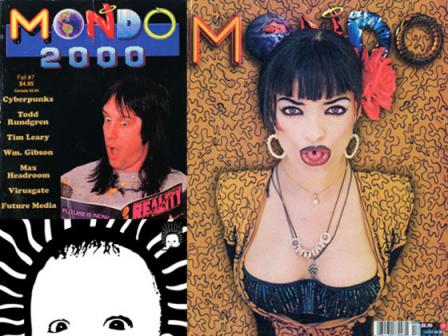For those who may not know, the late
and great cyberculture magazine Mondo 2000 represented a media
frontier of cultural experimentation, technological speculation,
virtual hyperbole, and psychedelic weirdness, the memetic
reverberations of which can still be felt to this day. Surfing a fine
line between the emerging high-brow information culture of the
digital literati, and the pranksterish and boisterous antinomianism
of cyberpunk, Mondo 2000 came to occupy a unique cultural
niche in the Bay Area of northern California in the late 80's and
across a wider spectrum of readership over time, eventually reaching
the cover of Time magazine in 1993.
Beginning as the publication High
Frontiers in 1984, edited by R. U. Sirius (a pseudonym of Ken
Goffman) and later Queen Mu (Alison Bailey Kennedy), the magazine then
became Reality Hackers in 1988, and eventually morphed into
the more long-lived and recognizable Mondo 2000.
Stylistically, at the time, Mondo 2000 was in a class of its
own. Taking advantage of the eminent era of graphic arts manipulation
in media, the magazine showed readers a vision of the technological
future through surrealistic and fantastic imagery as well as with
words. Linguistically, Mondo read like a user's guide to a new
reality: a map that was somewhat esoteric, scatterbrained, and
mystifying, but equally provocative and entertaining. Tapping some of
the most interesting literary and artistic figures of the day,
including William Gibson, Terence McKenna, Timothy Leary, Bruce
Sterling, John Perry Barlow, and many others, Mondo 2000 poised
itself as a drug-fueled counter culture think-tank and experimental
literary platform. The conspiracy theories, rants, pranks,
manifestos, and wild speculations which spoke from its pages were
influential to some, and incomprehensible to others.
Looking back, we can see that some
aspects of the prophetic vision of Mondo 2000 have indeed come
to pass. Today those born in the post-information age take for
granted the fact that computerized machines and electronic lines of
codes run many of the background processes of our lives–organizing,
connecting, and facilitating human civilization across the world.
Today you can follow the innermost thoughts of your favorite
celebrities, sports stars, or authors on Twitter, or scan a village
in Morocco via Google Earth. You can swap music, video, and document
files with people you may never meet in person, and R.S.V.P. to a
party on Facebook with your iPhone while playing electronic Scrabble
with someone in Thailand. There is no question that technology has
irrevocably altered the landscape of modern civilization, although
not necessarily in the way that the rebellious prognosticators who
ventured into the brave new electronic worlds of the early 90's may
quite have imagined.
Now former editor R.U. Sirius has been
working to put together a project that will provide an “open source
history” of the magazine, its triumphs and tribulations, with
commentary and interviews from people who were involved, as well as a
digitalization of the print magazine, to formulate a collaborative
narrative about the zeitgeist of the now infamous cyberpunk scene
which Mondo helped create.
You can check out and contribute to
the Mondo 2000 History Project here:
http://www.kickstarter.com/projects/1502076070/mondo-2000-an-open-source-history
And here you can read some of R.U. Sirius' juicey memoirs of the time:
http://www.kickstarter.com/projects/1502076070/mondo-2000-an-open-source-history/posts
Tristan Gulliford is a writer, dreamer, and aspiring myth-keeper
who makes electronic music under the name "Dreamcode".











